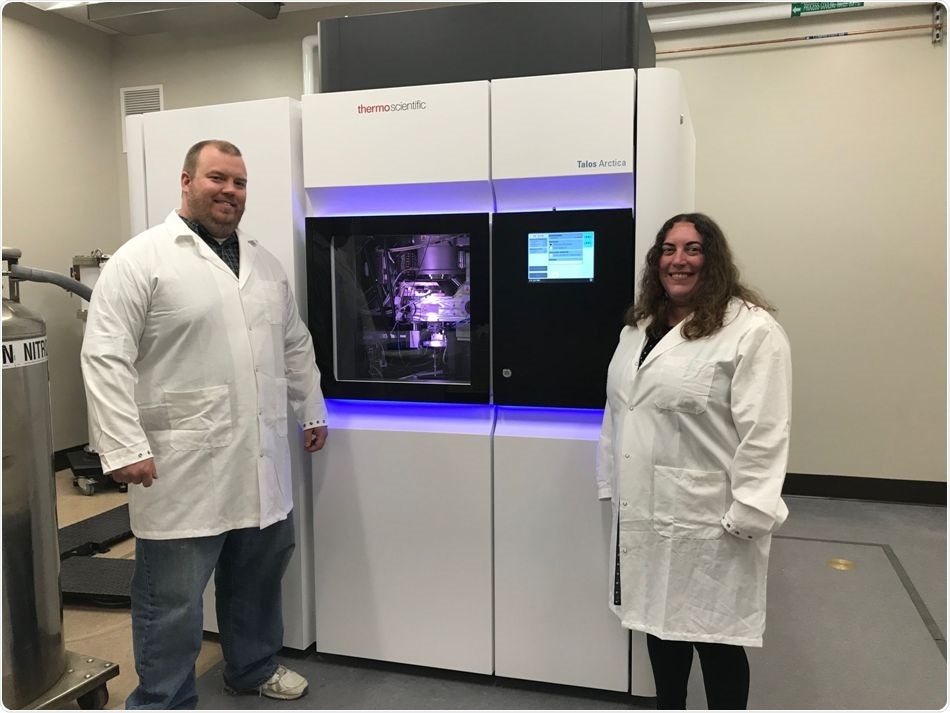In the recent past, researchers have uncovered giant viruses in some of the most enigmatic locations in the world, from Siberia’s thawing permafrost to locations unknown under the Antarctic ice.
But there is no reason to worry because “the Thing” is still a work of science fiction, at least for now.

Jason Schrad (left) and Kristin Parent pose next to a Talos Arctica microscope, a specialized instrument that images frozen samples to provide atomic-level molecular structures. Image Credit: John A. Dover.
Researchers from Michigan State University performed a new study that offers a new understanding of these mysterious yet fascinating giant microorganisms and the important aspects of the process through which they infect cells.
Using next-generation imaging technologies, the study designed a reliable model for analyzing giant viruses and is the first-ever research to detect and define a number of important proteins implicated in orchestrating infection.
Giant viruses, whose size is bigger than 300 nm, can survive for several millennia. In comparison, the rhinovirus that causes common cold measures about 30 nm.
Giant viruses are gargantuan in size and complexity. The giant viruses recently discovered in Siberia retained the ability to infect after 30,000 years in permafrost.”
Kristin Parent, Principal Investigator and Associate Professor, Department of Biochemistry and Molecular Biology, Michigan State University
Capsids, or the external shells, protect the genomes present inside. They are rugged and can tolerate adverse conditions. The study analyzed the capsids of species, such as the Samba virus, Antarctica virus, mimivirus, and the recently discovered Tupanviruses, which are all icosahedral or shaped like a 20-sided die.
The capsid species release their viral genome through a unique mechanism. A starfish-shaped seal sits on top of one of the external shell vertices. This exclusive vertex is called the “stargate.” The “stargate” and “starfish” open to discharge the viral genome at the time of infection.
During the analysis, many barriers had to be tackled. “Giant viruses are difficult to image due to their size and previous studies relied on finding the ‘one-in-a-million’ virus in the correct state of infection,” added Parent.
To overcome this problem, Parent’s graduate student Jason Schrad devised a new technique to mimic the stages of infection. Parent’s team used the university’s latest cryo-electron microscope as well as the scanning electron microscope to expose various species to a range of aggressive chemicals and environmental treatments developed to replicate conditions that would be experienced by a virus during the process of infection.
Parent added, “Cryo-EM allows us to study viruses and protein structures at the atomic level and to capture them in action. Access to this technology is very important and the new microscope at MSU is opening new doors for research on campus.”
The results demonstrated three environmental conditions that effectively caused the opening of the stargate, that is, high salt, high temperature, and low pH. Moreover, every condition led to a different stage of infection.
Armed with this latest data, Parent’s team developed a model to reliably and effectively imitate the infection stages for the study.
Parent added, “This new model now allows scientists to mimic the stages reliably and with high frequency, opening the door for future study and dramatically simplifying any studies aimed at the virus.”
The study outcomes led to many new findings.
We discovered that the starfish seal above the stargate portal slowly unzips while remaining attached to the capsid rather than simply releasing all at once. Our description of a new giant virus genome release strategy signifies another paradigm shift in our understanding of virology.”
Kristin Parent, Principal Investigator and Associate Professor, Department of Biochemistry and Molecular Biology, Michigan State University
With the potential to reliably reproduce different stages of infection, the scientists examined the proteins that were discharged by the virus during the initial stage.
Proteins serve as workers, orchestrating a number of biological processes that a virus needs to infect and hijack the reproductive capabilities of a cell to replicate itself.
The results of this study help to assign putative or assumed roles to many proteins with previously unknown functions, highlighting the power of this new model. We identified key proteins released during the initial stages of infection responsible for helping mediate the process and complete the viral takeover.”
Kristin Parent, Principal Investigator and Associate Professor, Department of Biochemistry and Molecular Biology, Michigan State University
Speaking about the plans for an upcoming study, Parent added, “The exact functions of many of these proteins and how they orchestrate giant virus infection are prime candidates for future study. Many of the proteins we identified matched proteins that one would expect to be released during the initial stages of viral infections. This greatly supports our hypothesis that the in vitro stages generated in this study are reflective of those that occur in vivo.”
The fact that many different types of giant viruses analyzed by the researchers responded analogously in vitro led the scientists to believe that these microbes share common characteristics and perhaps analogous proteins.
Whether giant viruses can infect human beings, unlike the coronavirus, is an emerging subject of discussion among virologists.
Source:
Journal reference:
Schrad, J. R., et al. (2020) Structural and Proteomic Characterization of the Initiation of Giant Virus Infection. Cell. doi.org/10.1016/j.cell.2020.04.032.